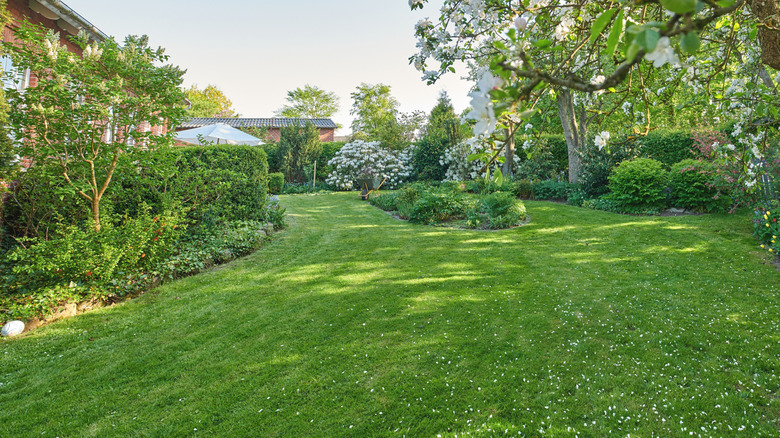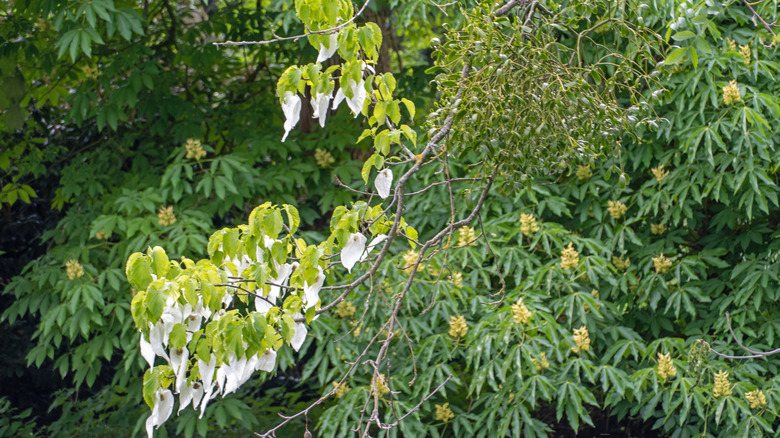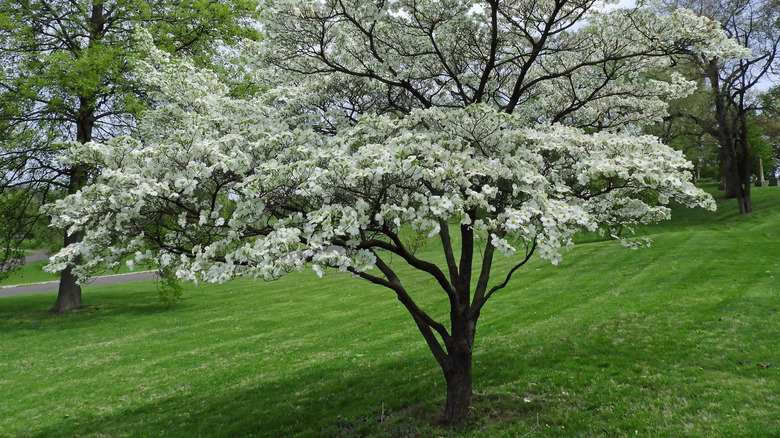The Elegant White Tree That You May Want To Reconsider Growing In Your Yard
The dove tree (Davidia involucrata) hails from China, though it's rarely grown even in its native range. The compact tree is well-known for its distinctive blooms. Its massive, fluffy flower heads are surrounded by two large, creamy white bracts — modified leaves that look similar to flower petals. They look lovely, but there's a problem: It can take 10 years or longer for this tree to begin flowering if started from seed. And even then, it doesn't produce a consistent display of blooms every year. When it finally does bloom, flowers may not appear on the entire tree.
In short, the dove tree is gorgeous when it does bloom. But it's slow to start and you can't count on an eye-catching display every year. If that inconsistency weren't enough, dove trees can also be pretty picky about their care. It's only hardy in USDA zones 6 through 8. It needs moist, nutrient-rich soil and won't tolerate drying. And, if you're hoping to see its prized flowers, maintaining optimal conditions as consistently as possible is key.
The good news is the dove tree isn't your only option for gorgeous white floral displays. From native flowering trees that attract hummingbirds to longer-blooming species that aren't as finicky as dove trees, you have plenty of more reliable alternatives to create the look you're going for in your garden. Learn more about why the dove tree may not be worth planting and which trees would make the best alternatives to this rare and stubborn species.
Why you might not want to plant a dove tree in your yard
As mentioned earlier, the dove tree can take a decade or more to start blooming when grown from seed. While other trees can take a long time to reach maturity from seed, too, the problem with the dove tree is that you have few ways to speed things up. With more common trees, you can shave a few years off your wait time by transplanting a tree that's already a few years old. But most dove trees are grown from seed, and you'll have a hard time finding transplants for sale.
Growing from seed is no easy feat, either. The seeds require a double dormancy period, so if you do take the long route, make sure you learn how to start these tricky seeds. With that said, some gardeners take its finicky care and rare flowering as a challenge. Being able to successfully grow a dove tree from seed and finally see it flower is a feat worth bragging about.
Even if you're prepared to take on the challenge, you might want to add a couple of more reliable flowering trees to your landscape. Because they often develop a pattern of alternate year blooming — only flowering every other year — it helps to have other specimen plantings to provide visual interest in the off years. Then you'll have something to enjoy every growing season, and the years when your dove tree does bloom will just be extra special.
Dove tree alternatives for a reliable spring display
Fortunately, dove trees are far from the only trees to put on an early spring display of white flowers. While alternative species might not have flowers with the same distinctive shape, there are many trees that bloom more consistently. You can also find flowering trees that are more readily available as transplants, so you can enjoy those blooms sooner.
One of the best trees with white flowers to plant instead of a dove tree is a flowering dogwood (Cornus florida). The North American native fills up with clusters of showy, white flowers every year in early spring. It also puts on a second display in late fall and winter when bright red berries cling to the branches long after the leaves drop. It's also much lower maintenance than a dove tree. However, you'll still want to help it get well-established in your yard, as healthier trees tend to produce more flowers than stressed ones.
Other dove tree alternatives for a spring display of showy flowers include eastern redbud (Cercis canadensis), serviceberry (Amelanchier spp.), and black cherry (Prunus serotina). The first two are also some of the longest-blooming flowering trees you could add to your yard. All are native to the United States and beloved for their spring flowers. Black cherry and serviceberry both have the added benefit of producing delicious fruit later in the season. Just be prepared to share the fruit with birds and any other local wildlife that finds it tasty.


